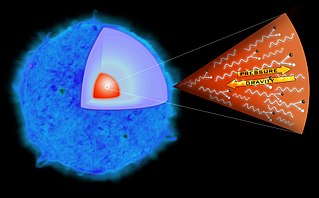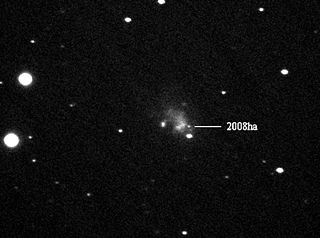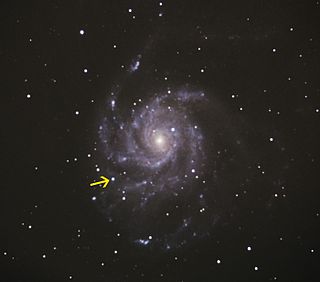The Chandrasekhar limit is the maximum mass of a stable white dwarf star. The currently accepted value of the Chandrasekhar limit is about 1.4 M☉ (2.765×1030 kg).

A supernova is a powerful and luminous explosion of a star. A supernova occurs during the last evolutionary stages of a massive star or when a white dwarf is triggered into runaway nuclear fusion. The original object, called the progenitor, either collapses to a neutron star or black hole, or is completely destroyed to form a diffuse nebula. The peak optical luminosity of a supernova can be comparable to that of an entire galaxy before fading over several weeks or months.

A blue supergiant (BSG) is a hot, luminous star, often referred to as an OB supergiant. They have luminosity class I and spectral class B9 or earlier.

A Type Ia supernova is a type of supernova that occurs in binary systems in which one of the stars is a white dwarf. The other star can be anything from a giant star to an even smaller white dwarf.

SN 1994D was a Type Ia supernova event in the outskirts of galaxy NGC 4526. It was offset by 9.0″ west and 7.8″ south of the galaxy center and positioned near a prominent dust lane. It was caused by the explosion of a white dwarf star composed of carbon and oxygen. This event was discovered on March 7, 1994 by R. R. Treffers and associates using the automated 30-inch telescope at Leuschner Observatory. It reached peak visual brightness two weeks later on March 22. Modelling of the light curve indicates the explosion would have been visible around March 3-4. A possible detection of helium in the spectrum was made by W. P. S. Meikle and associates in 1996. A mass of 0.014 to 0.03 M☉ in helium would be needed to produce this feature.
Carbon detonation or carbon deflagration is the violent reignition of thermonuclear fusion in a white dwarf star that was previously slowly cooling. It involves a runaway thermonuclear process which spreads through the white dwarf in a matter of seconds, producing a type Ia supernova which releases an immense amount of energy as the star is blown apart. The carbon detonation/deflagration process leads to a supernova by a different route than the better known type II (core-collapse) supernova.

The known history of supernova observation goes back to 1006 AD. All earlier proposals for supernova observations are speculations with many alternatives.

Type Ib and Type Ic supernovae are categories of supernovae that are caused by the stellar core collapse of massive stars. These stars have shed or been stripped of their outer envelope of hydrogen, and, when compared to the spectrum of Type Ia supernovae, they lack the absorption line of silicon. Compared to Type Ib, Type Ic supernovae are hypothesized to have lost more of their initial envelope, including most of their helium. The two types are usually referred to as stripped core-collapse supernovae.

A Type II supernova or SNII results from the rapid collapse and violent explosion of a massive star. A star must have at least eight times, but no more than 40 to 50 times, the mass of the Sun (M☉) to undergo this type of explosion. Type II supernovae are distinguished from other types of supernovae by the presence of hydrogen in their spectra. They are usually observed in the spiral arms of galaxies and in H II regions, but not in elliptical galaxies; those are generally composed of older, low-mass stars, with few of the young, very massive stars necessary to cause a supernova.

A pair-instability supernova is a type of supernova predicted to occur when pair production, the production of free electrons and positrons in the collision between atomic nuclei and energetic gamma rays, temporarily reduces the internal radiation pressure supporting a supermassive star's core against gravitational collapse. This pressure drop leads to a partial collapse, which in turn causes greatly accelerated burning in a runaway thermonuclear explosion, resulting in the star being blown completely apart without leaving a stellar remnant behind.
SN 2005gj was a supernova located approximately 864 million light years away from Earth. It was discovered on September 29, 2005, by the Sloan Digital Sky Survey and the Nearby Supernova Factory. 2005gj was noted because it had qualities of both type Ia and type IIn supernovae, and because hydrogen emission lines were found in its spectrum. These hydrogen lines, which were found on the spectrum at redshift z=0.0613, are thought to be indicative of interactions with a circumstellar medium by the supernova's ejected matter or white dwarf progenitor. Such emission lines are extremely rare in Type Ia supernovae – only one other Type Ia, SN 2002ic, has been observed to exhibit the same properties. However, 2005gj's CSM interaction was much stronger and more clearly observed than 2002ic's. The mass-loss history 2005gj's hydrogen lines suggest has been cited as evidence that luminous blue variable (LBV) hypergiants can be progenitors of thermonuclear supernovae.

SN 2008ha was a type Ia supernova which was first observed around November 7, 2008 in the galaxy UGC 12682, which lies in the constellation Pegasus at a distance of about 21.3 megaparsecs (69 Mly) from Earth.

Pilar Ruiz-Lapuente is an astrophysicist working as a professor at the University of Barcelona. Her work has included research on type Ia supernovae. In 2004, she led the team that searched for the companion star to the white dwarf that became supernova SN 1572, observed by Tycho Brahe, among others. Ruiz-Lapuente's research on supernovae contributed to the discovery of the accelerating expansion of the universe.

SN 2011fe, initially designated PTF 11kly, was a Type Ia supernova discovered by the Palomar Transient Factory (PTF) survey on 24 August 2011 during an automated review of images of the Messier 101 from the nights of 22 and 23 August 2011. It was located in Messier 101, the Pinwheel Galaxy, 21 million light years from Earth. It was observed by the PTF survey very near the beginning of its supernova event, when it was approximately 1 million times too dim to be visible to the naked eye. It is the youngest type Ia ever discovered. About 13 September 2011, it reached its maximum brightness of apparent magnitude +9.9 which equals an absolute magnitude of about -19, equal to 2.5 billion Suns. At +10 apparent magnitude around 5 September, SN 2011fe was visible in small telescopes. As of 30 September the supernova was at +11 apparent magnitude in the early evening sky after sunset above the northwest horizon. It had dropped to +13.7 as of 26 November 2011.
SN 1972E was a supernova in the galaxy NGC 5253 that was discovered 13 May 1972 with an apparent B magnitude of about 8.5, shortly after it had reached its maximum brightness. In terms of apparent brightness, it was the second-brightest supernova of any kind of the 20th century. It was observed for nearly 700 days, and it became the prototype object for the development of theoretical understanding of Type Ia supernovae.

SN 2014J was a type-Ia supernova in Messier 82 discovered in mid-January 2014. It was the closest type-Ia supernova discovered for 42 years, and no subsequent supernova has been closer as of 2023. The supernova was discovered by chance during an undergraduate teaching session at the University of London Observatory. It peaked on 31 January 2014, reaching an apparent magnitude of 10.5. SN 2014J was the subject of an intense observing campaign by professional astronomers and was bright enough to be seen by amateur astronomers.

A zombie star is a hypothetical result of a Type Iax supernova which leaves behind a remnant star, rather than completely dispersing the stellar mass. Type Iax supernovae are similar to Type Ia, but have a lower ejection velocity and lower luminosity. Type Iax supernovae may occur at a rate between 5 and 30 percent of the Ia supernova rate. Thirty supernovae have been identified in this category.

Hen 2-428 is a planetary nebula with a binary double white dwarf system core. This core star system is the first discovered candidate for Type Ia supernova through binary white dwarf merger process. At the time of its discovery, the star system at the core was the heaviest known double white dwarf binary star system.
Ken'ichi Nomoto is a Japanese astrophysicist and astronomer, known for his research on stellar evolution, supernovae, and the origin of heavy elements.














